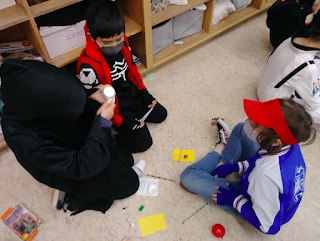The Changing Colours of Fall
Science: I can observe and connect with nature; I can reflect on observations, notice changes & patterns.
Art: I can create realistic drawings. I can explore colour.
 Yesterday, we went on a Community Walk so that we could learn about and capture the fall colours through art. On the walk, we saw Canadian geese, a magpie nest, a chickadee, a northern flicker (and some dinosaurs!).
Yesterday, we went on a Community Walk so that we could learn about and capture the fall colours through art. On the walk, we saw Canadian geese, a magpie nest, a chickadee, a northern flicker (and some dinosaurs!). "On some of the trees, some of the leaves were still changing colours. On the same tree, we saw yellow and green." ~ Rochael
"On the leaves, when the leaves start to turn red or yellow, they start on the outside." ~ Sebastian K
"I realized that when the leaves start to change colour, the top left of the tree was yellow and other parts were still green." ~ Dillon
"Some leaves that I found were kind of looking like a tree that was set on fire." ~ Sebastian C
"When I was walking, I noticed that some trees had almost lost all of their leaves." ~ Callie
"I noticed that the tree doesn't just doesn't stop producing chlorophyll all at once. It slowly changes." ~ Hazel
"The reason that some of the leaves were yellow was because they didn't have any chlorophyll. So, we could see the carotenoids (the pigment that makes leaves yellow or orange." ~ Leo
 |
| This is the Wild Rose plant. We stopped to observe the changing colours. The Wild Rose was losing its chlorophyll. Some leaves were turning red. Some leaves were still green. |
After our walk, we stopped at the top of the hill to sketch what we'd seen. We could choose to zoom in and focus on one leaf, or one tree, or do a landscape showing the fall colour.







